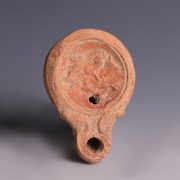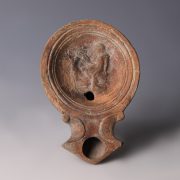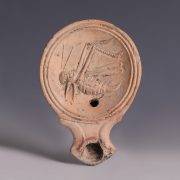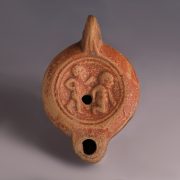In classical mythology, the deer or stag was associated with the ancient Roman goddess Diana (or her Greek counterpart, Diana), in her role as the virginal huntress. One popular myth tells the story of the hero Actaeon, who, after witnessing the goddess bathing, was turned into a stag. He was chased by his own hunting hounds and perished. Such a lamp could have been given as an offering to Artemis, or belonged to a young hunter, thereby evoking the goddess’s protection and guidance.
This particular lamp is classified as form Loeschcke VIII; Bussière form D X 1, variation c. This refers specifically to a typology of lamps, dated by style and form. This particular classification is characterised by the ovolo decoration to the shoulders, heart-shaped nozzle and ring handle. The ovolo motif was initially used on Hellenistic lamps, although these tended to be smaller and more rounded at the ends. The style became elongated and more rectangular towards the end of the 1st century and was especially popular in the 2nd century AD. This particular variation of Bussière form D X 1 was also centred in North Africa and dated from circa AD 138 to AD 215.
To discover more about oil lamps in Antiquity, please visit our relevant blog post: Lighting The Way.







